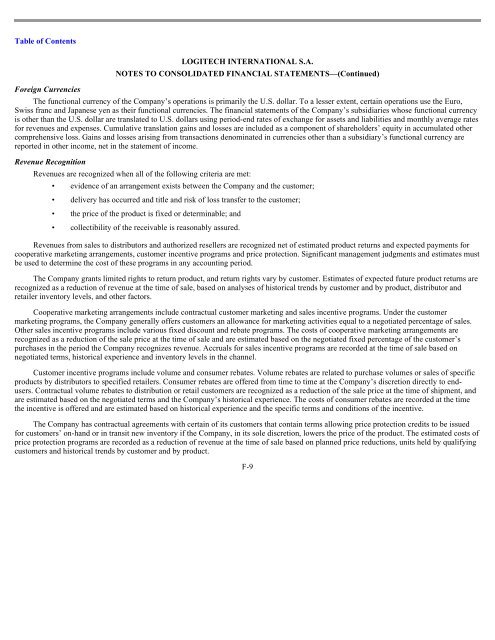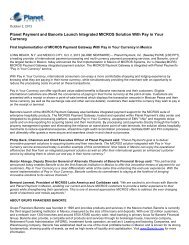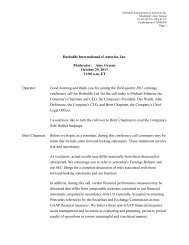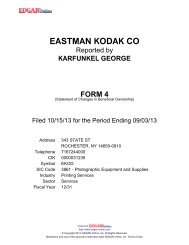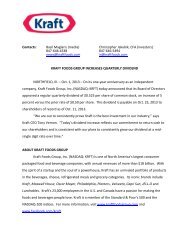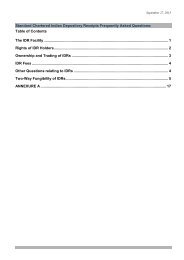LOGITECH INTERNATIONAL SA - Shareholder.com
LOGITECH INTERNATIONAL SA - Shareholder.com
LOGITECH INTERNATIONAL SA - Shareholder.com
You also want an ePaper? Increase the reach of your titles
YUMPU automatically turns print PDFs into web optimized ePapers that Google loves.
Table of Contents<br />
Foreign Currencies<br />
<strong>LOGITECH</strong> <strong>INTERNATIONAL</strong> S.A.<br />
NOTES TO CONSOLIDATED FINANCIAL STATEMENTS—(Continued)<br />
The functional currency of the Company’s operations is primarily the U.S. dollar. To a lesser extent, certain operations use the Euro,<br />
Swiss franc and Japanese yen as their functional currencies. The financial statements of the Company’s subsidiaries whose functional currency<br />
is other than the U.S. dollar are translated to U.S. dollars using period-end rates of exchange for assets and liabilities and monthly average rates<br />
for revenues and expenses. Cumulative translation gains and losses are included as a <strong>com</strong>ponent of shareholders’ equity in accumulated other<br />
<strong>com</strong>prehensive loss. Gains and losses arising from transactions denominated in currencies other than a subsidiary’s functional currency are<br />
reported in other in<strong>com</strong>e, net in the statement of in<strong>com</strong>e.<br />
Revenue Recognition<br />
Revenues are recognized when all of the following criteria are met:<br />
• evidence of an arrangement exists between the Company and the customer;<br />
• delivery has occurred and title and risk of loss transfer to the customer;<br />
• the price of the product is fixed or determinable; and<br />
• collectibility of the receivable is reasonably assured.<br />
Revenues from sales to distributors and authorized resellers are recognized net of estimated product returns and expected payments for<br />
cooperative marketing arrangements, customer incentive programs and price protection. Significant management judgments and estimates must<br />
be used to determine the cost of these programs in any accounting period.<br />
The Company grants limited rights to return product, and return rights vary by customer. Estimates of expected future product returns are<br />
recognized as a reduction of revenue at the time of sale, based on analyses of historical trends by customer and by product, distributor and<br />
retailer inventory levels, and other factors.<br />
Cooperative marketing arrangements include contractual customer marketing and sales incentive programs. Under the customer<br />
marketing programs, the Company generally offers customers an allowance for marketing activities equal to a negotiated percentage of sales.<br />
Other sales incentive programs include various fixed discount and rebate programs. The costs of cooperative marketing arrangements are<br />
recognized as a reduction of the sale price at the time of sale and are estimated based on the negotiated fixed percentage of the customer’s<br />
purchases in the period the Company recognizes revenue. Accruals for sales incentive programs are recorded at the time of sale based on<br />
negotiated terms, historical experience and inventory levels in the channel.<br />
Customer incentive programs include volume and consumer rebates. Volume rebates are related to purchase volumes or sales of specific<br />
products by distributors to specified retailers. Consumer rebates are offered from time to time at the Company’s discretion directly to endusers.<br />
Contractual volume rebates to distribution or retail customers are recognized as a reduction of the sale price at the time of shipment, and<br />
are estimated based on the negotiated terms and the Company’s historical experience. The costs of consumer rebates are recorded at the time<br />
the incentive is offered and are estimated based on historical experience and the specific terms and conditions of the incentive.<br />
The Company has contractual agreements with certain of its customers that contain terms allowing price protection credits to be issued<br />
for customers’ on-hand or in transit new inventory if the Company, in its sole discretion, lowers the price of the product. The estimated costs of<br />
price protection programs are recorded as a reduction of revenue at the time of sale based on planned price reductions, units held by qualifying<br />
customers and historical trends by customer and by product.<br />
F-9


